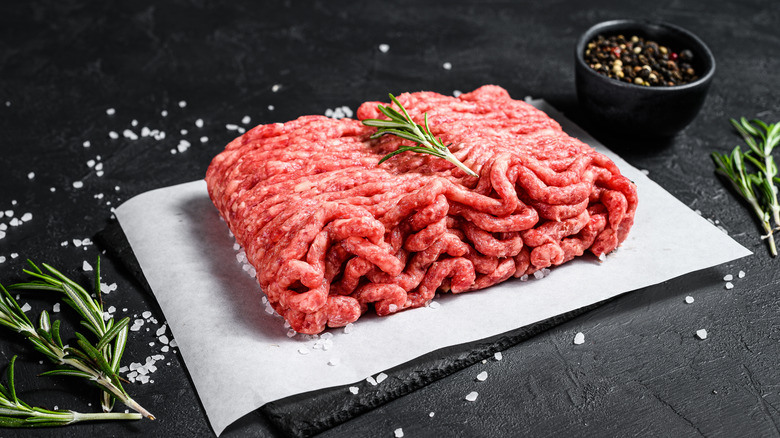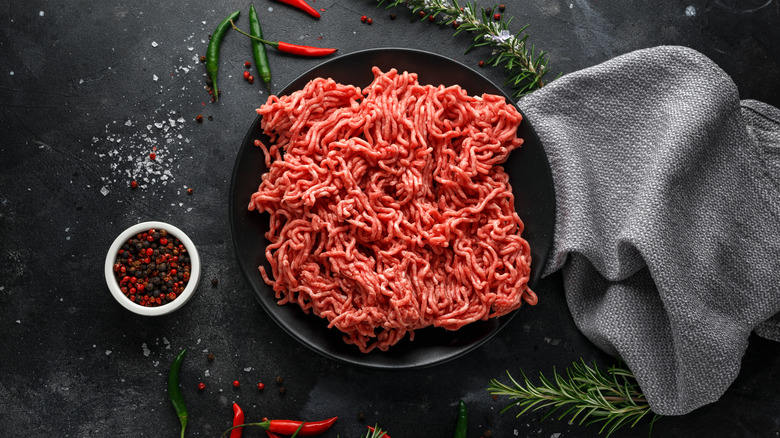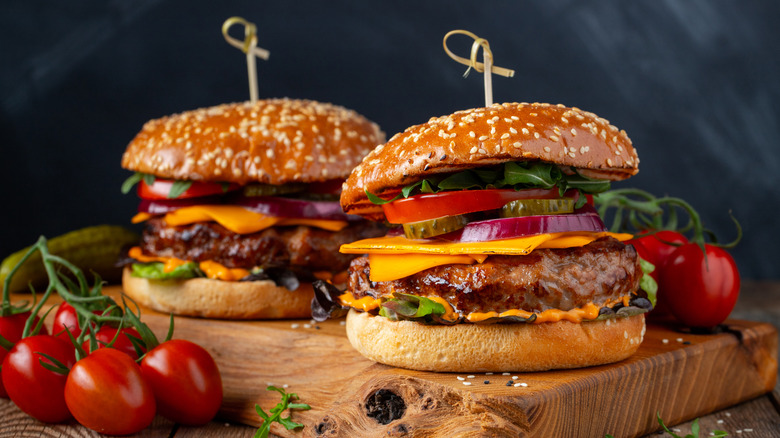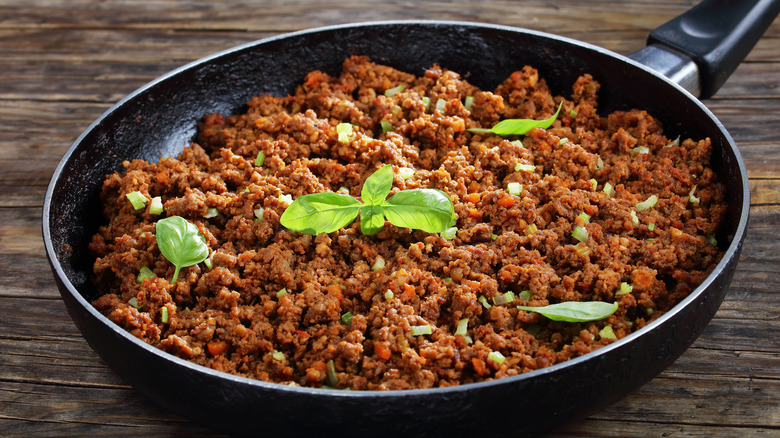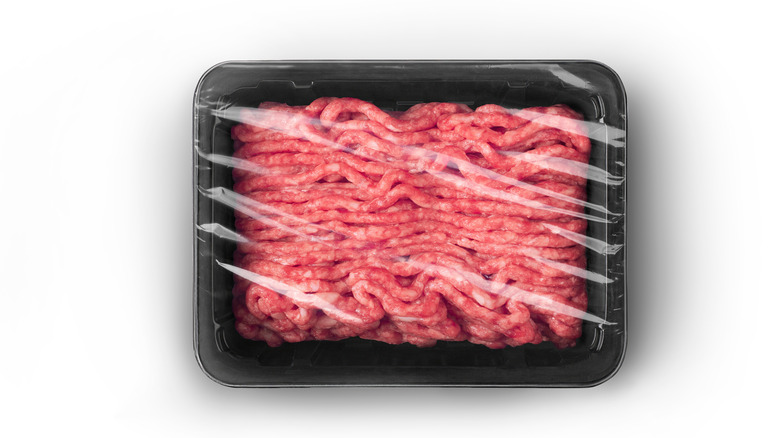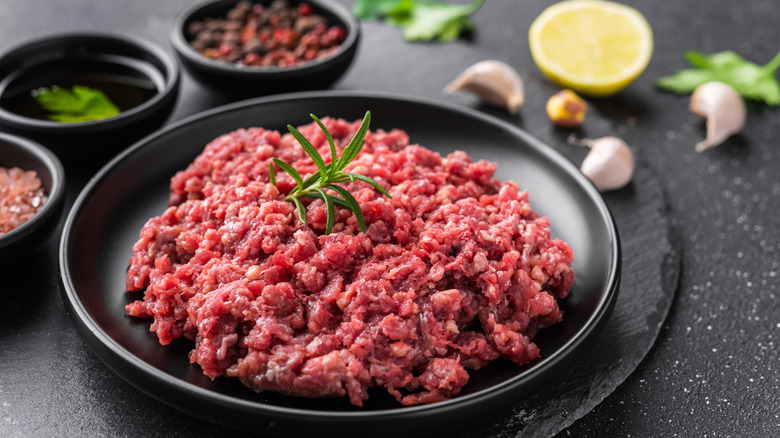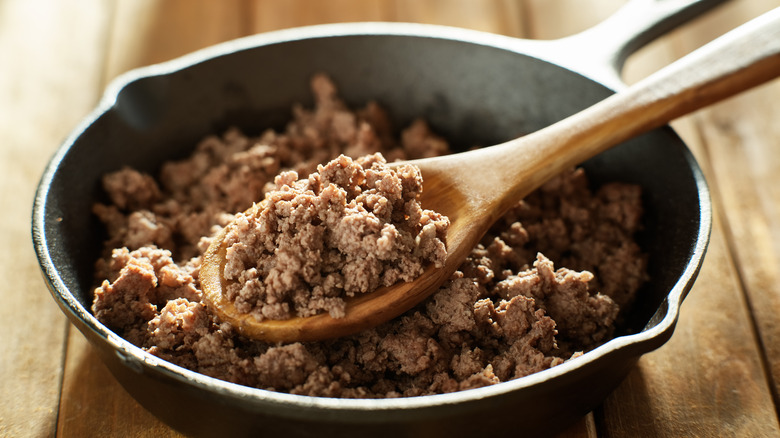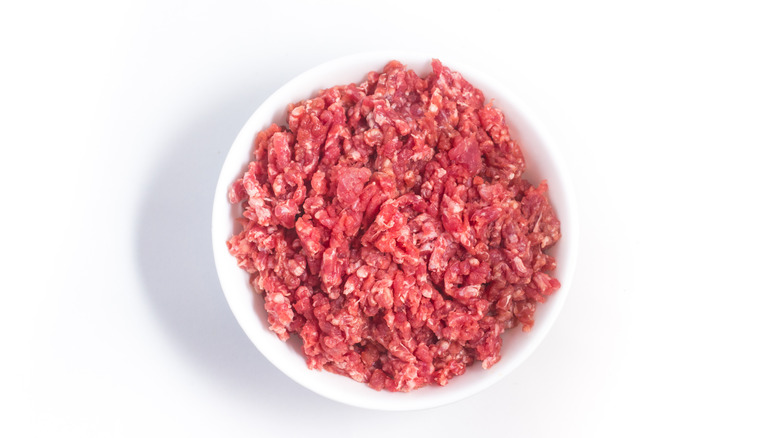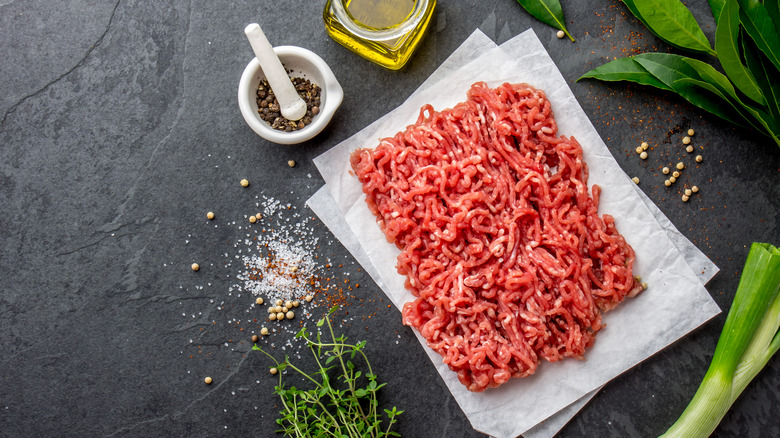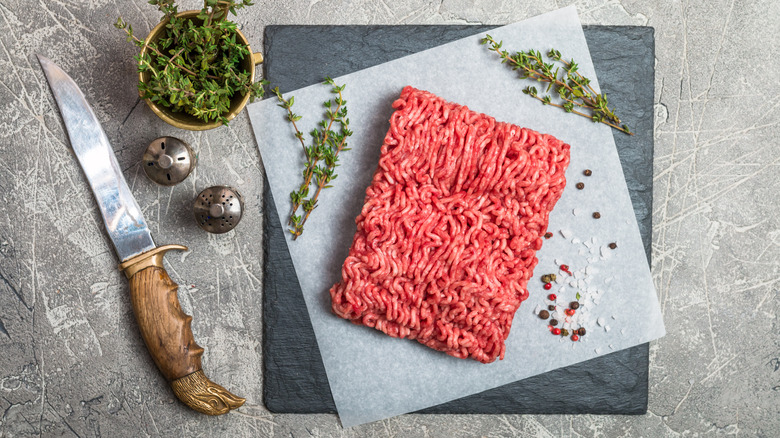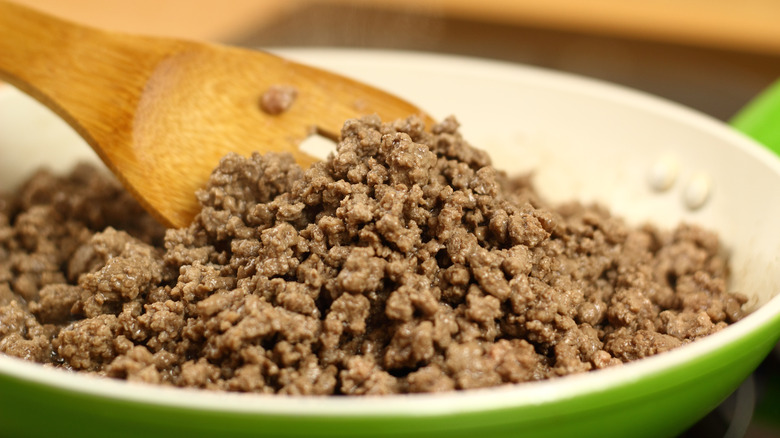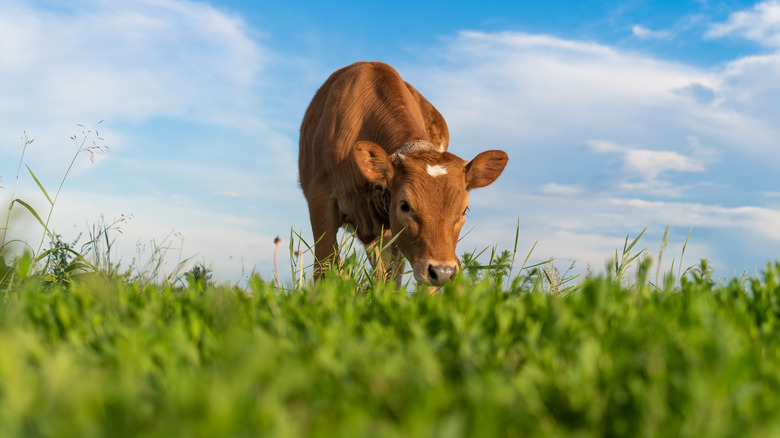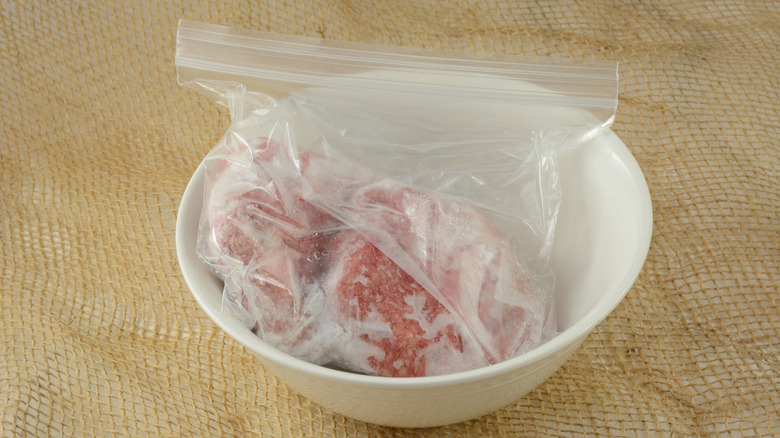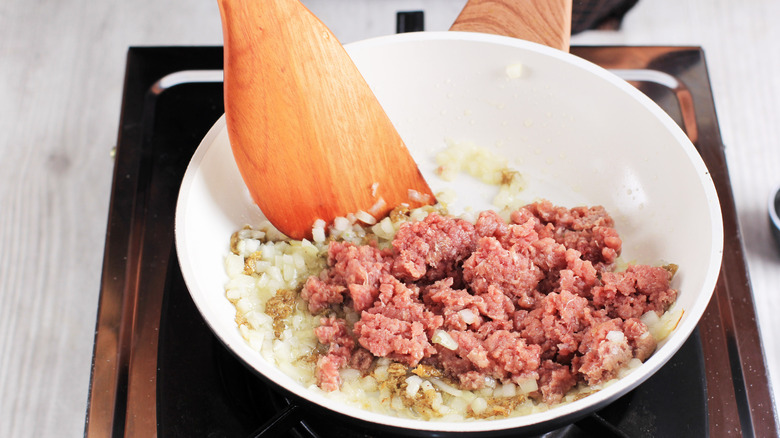Ground Beef Myths Everyone Actually Believes
Ground beef is one of those staple proteins that everyone seems to have in their fridge or freezer from time to time. It can be used in a ton of different recipes, and it tends to be something that's easy to throw together, even if you don't start cooking until the last minute. That makes ground beef a great option in a lot of different cases. But what you may not realize is the fact that there are several myths about ground beef floating around out there. Some are obviously wrong, while others sound like they could be legit. So how do you know what's true and what's just a myth?
Don't worry — we've done the research for you so you don't end up falling victim to those prevalent ground beef myths. Take a look at some of the most common misinformation about ground beef you may encounter so you know what not to believe the next time you start cooking. That way, you can ensure your ground beef is cooked to absolute perfection each and every time.
Color is a good indicator if your ground beef is fresh
Perhaps one of the most common myths out there is the idea that the color of your ground beef determines how fresh it is. This sounds reasonable. After all, would you ever consider buying a piece of meat that looked gray or greenish? Probably not. And at one time, color may have been a smart way to determine whether you were getting fresh ground beef. Now, though, that's just not the case. Why? Because, according to the American Meat Institute, carbon monoxide is added to packages of beef you see in stores.
This addition is not technically classed as a color additive, but it does change the color of the beef, making it look redder and less aged. While this may not be a huge problem, it could lead you to believe that the ground beef you're buying is actually a lot fresher than it is. If you truly want to gauge the freshness of the meat you're buying, you're better off paying attention to the smell and the texture. Make sure it's not slimy or too soft, and if it smells bad, it probably is.
Ground beef is only really good for burgers
When a lot of people hear the words "ground beef," they automatically think of burgers. Of course, this is a common use for ground beef, but that doesn't mean that it's all the meat is good for. In fact, there are countless recipes you can make in which you can utilize ground beef — and no, we're not just talking about Hamburger Helper. A meatloaf is a classic example of a recipe that calls for ground beef, even though you can bulk that meat up with whatever else you have lying around in the fridge.
The options for ground beef recipes really are endless. Make chili, meatballs, or ragu, or simply use it as a replacement for other meats in stir frys and other dishes where meat isn't necessarily the star of the show. Because of its versatility, ground beef can work well in tons of recipes that you may never think of. So don't feel limited by the burger-or-bust mindset. Expand your horizons, and find a new recipe when you need to use up that ground beef in your fridge.
You can put as much ground beef in a pan as you want
Ground beef is one of those meats that's great to cook for a big group of people. It's generally not too expensive, and it can be used to bulk up recipes that otherwise wouldn't be too filling. Because it lends itself to large-batch cooking so well, many people believe the myth that they can fill a pan to capacity with ground beef, and it won't have any problems cooking. However, we're here to inform you that that's just not the case, unfortunately.
You're not going to want to crowd your pan with ground beef. In fact, you shouldn't cook more than about one pound of ground meat in a pan at a time. If you do have to cook more than that, it's a good idea to cook it in batches. Remember to allow the pan to heat up again when you add the second batch.
The reason you'll want to avoid overcrowding the pan is because you don't want the ground beef to steam instead of browning. When there's too much meat in the pan, extra moisture gets trapped there, and you won't be able to develop that lovely brown crust you're looking for in most recipes.
Packaged ground beef is the best stuff out there
Most of the time, when you're at the grocery store, you probably want to get in and get out as fast as possible. Sure, grocery shopping can be fun, but when you're at the tail end of a long day and you're just trying to figure out how you're going to put dinner on the table, the last thing you want to do is spend any additional time by the meat cases. But when it comes to ground beef, a little extra effort can go a long way. Cookbook author Meathead Goldwyn explains to Epicurious that buying ground beef that's already been pre-ground is definitely not the way to go. He tells the outlet, "If you just pick up a package of something labeled ground meat, you're getting the lowest common denominator."
But don't worry — you're not going to have to go visit a butcher just to get the high-quality meat you're looking for. You can get top-notch stuff at your grocery store butcher's counter if you just know what to ask for. Pick a cut of meat that has the right amount of fat for whatever you're cooking, and ask for your butcher to grind it on the spot. Depending on the cut of meat you opt for, this could be slightly more expensive than the packaged stuff, but trust us: It's going to taste way, way better than that pre-ground meat ever could.
The fat percentage of your ground beef doesn't really matter
If you're the kind of person who only cares that your purchasing ground beef and doesn't check the label to specify precisely what you're getting, then there's a good chance that you've bought into this myth: The fat percentage of your ground beef is irrelevant. Or perhaps you believe the myth that you'll always want to go with the leanest beef you can find. Both of these beliefs are untrue, and while abiding by these rules may not cause you any major issues, it will mean that your ground beef probably isn't as good as it could be.
Kitchn explains that different fat percentages work better for different dishes. For example, if you're cooking burgers, you'll want to look for 80/20 ground beef. (That means 20% fat.) This is because you're going to want some fat for a juicy burger, but you won't want to overdo it. On the other hand, if you're making a meatloaf, you're going to want even fattier ground beef: Go for 70/30. This is because meatloaf cooks for a long time, so it's likely going to lose a lot of its moisture before you take it out of the oven.
But what if you're mixing pork and beef for meatballs or ragu? In that case, you can choose the really lean stuff. In general, 90/10 should work well. Since you'll get so much fat from the pork, it's not necessary to add even more with your beef.
It's fine to add your ground beef to a cold pan
This is a myth that's not limited to ground beef, but most home cooks probably don't pay attention to this issue quite as much when they're cooking ground beef as they would if they were cooking a steak. You're not going to want to add your ground beef to a cold pan. First, you should bring the pan up to temperature. Then, add in your oil (if you're using any), and make sure that comes up to heat next. Finally, you can put your meat in the pan. Yes, waiting for these steps does take some extra time, but it's all worth it in the end.
This is because you're not likely to get the kind of browning you're going for when you forget to heat your pan up. And when it comes to ground beef, that browning is of the utmost importance. But luckily, this extra step doesn't take any extra skills: Just wait a few extra minutes before you throw your beef in the pan, and you shouldn't have any problems.
Lean ground beef is a healthy option
These days, more and more people are going on paleo or keto diets, limiting their intake of carbs and piling on meat, meat, and more meat. There's a myth going around that the more meat and the more protein in your diet, the better — regardless of where it comes from. And don't forget the myth that fat is bad for you in general. Combine those two myths, and you have one that's as common as they come: Lean ground beef can be a healthy option, especially if you're on a low-carb diet.
We hate to break it to you, but that's just not true. According to Tufts University, eating red meat isn't particularly good for your health. While a "modest intake" of red meat probably isn't too terrible for you, it's certainly not a health food. And if you eat too much of it, you could be putting yourself at risk of health problems. That's right: Too much red meat consumption is linked to an increased risk of type 2 diabetes. And research has found that there aren't many benefits to eating leaner rather than fattier beef.
So, yes, you can continue to enjoy your ground beef from time to time, but it definitely shouldn't be regarded as a health food, even if you opt for the leanest variety available.
Taking your meat straight out of the fridge into the pan is a good idea
We get it: When you're ready to cook, you just want to throw everything into the pan without much forethought. And if you buy into the ground beef myths floating around, you may actually do it. But if you're cooking ground beef, that's generally not the best way to do things. It's important to bring your meat up to room temperature before you throw it into the pan. Why? Well, you already know how important it is to bring your pan up to the proper heat before you start cooking. If you add meat to the pan when it's still cold, it's just going to lower the temperature of the pan, which could cause issues if you're going for nice, even browning.
Another downside to doing things this way? It can cause your ground beef to lose all those juices that make it so flavorful, leaving you with a pile of subpar cooked beef and a puddle of beef juice that you can't really use for anything. Moral of the story: Remember to take your ground beef out of the fridge well before you start cooking for optimal results.
It's not necessary to season your ground beef until it's cooked
Generally speaking, ground beef isn't served on its own. If you're making a big pan of ground beef, it's probably just a component of a larger dish. That may lead you to believe the myth that you don't have to add any seasoning to your meat until it's done cooking and you add it to whatever else you're making. But this is a big no-no if you want your ground beef to be as flavorful as possible, per Taste of Home.
That's because adding seasonings to your ground beef early on in the cooking process allows those flavors to truly meld and develop over time, giving you a much richer, more enjoyable taste. This usually means adding salt and fresh cracked black pepper — powdered spices can easily burn in the pan if you're cooking on high heat, so they're not advised. Once you take this step, you'll be blessed with well-seasoned meat that will add way more flavor to whatever dish you're cooking.
It's safe to walk away while you're cooking your ground beef
It's important not to believe this myth for two reasons. The first reason comes in when you're browning meat. If you take the time to heat up your pan and oil and you wait for your meat to come to temperature before you start cooking it, it's not going to take a long time to brown your ground beef. You're looking for a nice sear and a little browning, but if you're including your browned ground beef in another recipe, you're not going to want to cook it all the way through. If you throw that already-cooked beef in the oven for an hour with all of your other ingredients, it's likely to be dry and overcooked by the time you take it out.
The more obvious reason you won't want to walk away from your ground beef when it's on the stove all comes down to safety, and it isn't specific to beef. It can be unsafe to have food cooking on the stove for too long while you're in another room. But you already knew that!
Grass-fed ground beef is healthier than conventional beef
Listen, we know that going to the grocery store is expensive, especially these days, so we want to help you cut costs whenever possible. Therefore, we can't let you continue to believe that you're getting a much healthier product when you choose grass-fed ground beef over the conventional stuff. Don't believe us? Just take it from Tufts University. They say that there's no evidence that grass-fed beef is actually better for your health than the average, often less-expensive ground beef you see on store shelves.
First of all, "grass-fed" or "pasture-raised" are marketing terms more than anything else. There's actually no agency that regulates the usage of these terms, so technically, any farmer could claim that their cows are grass-fed, even if they mostly aren't. Second of all, there isn't much evidence to support the idea that grass-fed ground beef is much healthier than the conventional stuff.
Of course, this beef could be better for the animals and for the planet, so we're not telling you to avoid buying it. However, you just shouldn't believe the myth that it's better for your health — there's just no data to support that claim.
You can thaw your ground beef on the counter
Have you fallen victim to the myth that it's safe to thaw ground beef on the counter? If you have, you're not alone. There's a belief that it won't actually cause any harm, and since it's much quicker than thawing in the fridge, it can seem like a solid option. But we're here to tell you that this myth is just that: a myth. It's definitely not safe to defrost ground beef on the counter at room temperature. This could promote the growth of harmful bacteria that could potentially cause illness to you, your family, or your guests — clearly something you'll want to avoid.
So, how exactly are you supposed to thaw your ground beef then? Well, the fridge is certainly one option. It's easy, and you don't have to think about it much. But it can take a lot of forethought and a lot of time, so it may not be ideal for everyone. If you want to thaw your beef quicker, you can always use a microwave. Our preferred method is throwing it in some cool water. Whatever you choose to do, just don't thaw it on the counter!
You should move your ground beef around in a pan as soon as you put it in
When it comes to expensive cuts of meat like a nice steak, there are countless pieces of advice to ensure you're cooking your meat well so you get the best bang for your buck. But when it comes to ground beef, there is much less info. However, just because it's a cheaper cut of meat doesn't mean you shouldn't follow some basic steps to ensure it comes out as good as it can be. With ground beef, some home cooks believe the myth that you should move it around in the pan as soon as you drop it in. However, Taste of Home reminds us that this actually isn't a good idea if you really want to get enough browning.
In fact, they recommend that you should actually wait about five minutes after putting your ground beef in the pan before you start moving it around. That will give it some nice color to start with, making for a more flavorful base for whatever else you're making.
